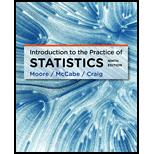
Concept explainers
(a)
To find: The pooled estimate of the standard deviation with degree of freedom.
(a)
Answer to Problem 39E
Solution: The pooled estimate of the standard deviation is 38.14 with degree of freedom 105.
Explanation of Solution
Calculation: The pooled variance can be calculated as
where
The degrees of freedom can be calculated as
(b)
To test: Whether it is appropriate to use a pooled standard deviation for the provided analysis.
(b)
Answer to Problem 39E
Solution: Yes, it is appropriate to use a pooled standard deviation for the provided analysis.
Explanation of Solution
Calculation: If the largest standard deviation of a group is less than the twice of the smallest standard deviation, then one can use the pooled standard deviation for the analysis. That is,
Conclusion: The largest pooled standard deviation for the provided analysis is 42.4, which is less than twice the smallest pooled standard deviation of the provided analysis. Therefore, it is appropriate to use a pooled standard deviation for the provided analysis.
(c)
To find: The marginal means.
(c)
Answer to Problem 39E
Solution: The marginal means of sender individual is 70.9, for sender group is 48.85, for responder individual is 59.75, and for responder group is 60.
Explanation of Solution
Calculation: Marginal mean is calculated by the average of row or column of the provided table. The marginal means of sender individual can be calculated as
The marginal means of sender group can be calculated as
The marginal means of responder individual can be calculated as
The marginal means of responder group can be calculated as
Therefore, the marginal means of sender individual is 70.9, for sender group is 48.85, for responder individual is 59.75, and for responder group is 60.
(d)
To graph: The means.
(d)
Explanation of Solution
Calculation: To plot the means, use Minitab and follow the steps below:
Step 1: Open the Minitab worksheet.
Step 2: Go to ANOVA > Interaction plot.
Step 3: Select “Mean” in the column for “Responses” and select “Respondent and Sender” in the column for “Factors.”.
The plot for means is obtained as

Interpretation: The patterns are not parallel. It can be seen from the plot that there is an interaction among sender and responder. So, there is an interaction among group A and group B. This interaction is significant as two lines are not parallel to each other.
(e)
To find: P-values and its interpretation for the F-statistics.
(e)
Answer to Problem 39E
Solution: The sender effect is significant as P-value is less than 0.05 significance level. The responder effect is not significant as P- value is greater than 0.05. The interaction effect is not significant as P- value is greater than 0.05.
Explanation of Solution
Calculation: The degree of freedom for sender is calculated by
The degree of freedom for responder is calculated by
The degree of freedom for interaction is calculated by
The degree of freedom for error term is calculated by
The P-value for sender group can be calculated by using the formula

The P-value for responder group can be calculated by using the formula

The P-value for interaction can be calculated by using the formula

Interpretation: Therefore only the sender effect is significant as P-value is less than 0.05 significance level. The responder effect is not significant as P- value is greater than 0.05. The interaction effect is not significant as P- value is greater than 0.05.
Want to see more full solutions like this?
Chapter 13 Solutions
Introduction to the Practice of Statistics
 MATLAB: An Introduction with ApplicationsStatisticsISBN:9781119256830Author:Amos GilatPublisher:John Wiley & Sons Inc
MATLAB: An Introduction with ApplicationsStatisticsISBN:9781119256830Author:Amos GilatPublisher:John Wiley & Sons Inc Probability and Statistics for Engineering and th...StatisticsISBN:9781305251809Author:Jay L. DevorePublisher:Cengage Learning
Probability and Statistics for Engineering and th...StatisticsISBN:9781305251809Author:Jay L. DevorePublisher:Cengage Learning Statistics for The Behavioral Sciences (MindTap C...StatisticsISBN:9781305504912Author:Frederick J Gravetter, Larry B. WallnauPublisher:Cengage Learning
Statistics for The Behavioral Sciences (MindTap C...StatisticsISBN:9781305504912Author:Frederick J Gravetter, Larry B. WallnauPublisher:Cengage Learning Elementary Statistics: Picturing the World (7th E...StatisticsISBN:9780134683416Author:Ron Larson, Betsy FarberPublisher:PEARSON
Elementary Statistics: Picturing the World (7th E...StatisticsISBN:9780134683416Author:Ron Larson, Betsy FarberPublisher:PEARSON The Basic Practice of StatisticsStatisticsISBN:9781319042578Author:David S. Moore, William I. Notz, Michael A. FlignerPublisher:W. H. Freeman
The Basic Practice of StatisticsStatisticsISBN:9781319042578Author:David S. Moore, William I. Notz, Michael A. FlignerPublisher:W. H. Freeman Introduction to the Practice of StatisticsStatisticsISBN:9781319013387Author:David S. Moore, George P. McCabe, Bruce A. CraigPublisher:W. H. Freeman
Introduction to the Practice of StatisticsStatisticsISBN:9781319013387Author:David S. Moore, George P. McCabe, Bruce A. CraigPublisher:W. H. Freeman





